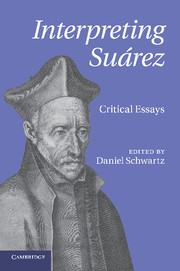Book contents
- Frontmatter
- Contents
- Notes on contributors
- Acknowledgements
- Abbreviations and method of citation
- Chapter 1 Introduction
- Chapter 2 Fundamentals in Suárez's metaphysics: transcendentals and categories
- Chapter 3 The reality of substantial form: Suárez, Metaphysical Disputations xv
- Chapter 4 Suárez on the ontology of relations
- Chapter 5 Suárez's cosmological argument for the existence of God
- Chapter 6 Action and freedom in Suárez's ethics
- Chapter 7 Obligation, rightness, and natural law: Suárez and some critics
- Chapter 8 Suárez on distributive justice
- Chapter 9 Suárez on just war
- Bibliography
- Index
Chapter 2 - Fundamentals in Suárez's metaphysics: transcendentals and categories
Published online by Cambridge University Press: 05 December 2011
- Frontmatter
- Contents
- Notes on contributors
- Acknowledgements
- Abbreviations and method of citation
- Chapter 1 Introduction
- Chapter 2 Fundamentals in Suárez's metaphysics: transcendentals and categories
- Chapter 3 The reality of substantial form: Suárez, Metaphysical Disputations xv
- Chapter 4 Suárez on the ontology of relations
- Chapter 5 Suárez's cosmological argument for the existence of God
- Chapter 6 Action and freedom in Suárez's ethics
- Chapter 7 Obligation, rightness, and natural law: Suárez and some critics
- Chapter 8 Suárez on distributive justice
- Chapter 9 Suárez on just war
- Bibliography
- Index
Summary
We think about the world in more or less general terms. Among the less general are terms such as ‘cat’ or ‘red,’ and among the more general, ‘animal’ or ‘color.’ Part of what philosophers do is to establish an order among the levels of generality expressed by these terms and determine their relations. The task is not very difficult at lower levels. It is easy to understand that red is a kind of color and therefore that ‘color’ expresses a higher level of generality than ‘red.’ But metaphysicians go beyond these lower levels of generality and try to establish an ordered list of the highest levels, turning to items such as substance, quality, being, and unity, and asking questions such as: How many of these most general levels are there? What are their members? And how are they related to each other and to lower levels? For example, they might ask whether substance and being belong to the same level of generality, and about the identity of the level or levels to which they belong. And they might do the same with unity and being, or quality and substance. Once metaphysicians find answers to these questions, they turn to more specific levels, such as red, color, cat, and animal, and inquire into how they are related to the more general ones.
Following the example of Aristotle, scholastic philosophers tried to establish a map of the most general levels of generality, while determining their interrelations, status, distinction, and the disciplines where they should be explored. During the Middle Ages and in the early modern period, two levels of generality in particular became the subject of considerable attention: transcendentals and categories. Most often scholastics thought of transcendentals as being and its properties and placed them at the top. Below this level, scholastics placed categories, which they understood to be divisions of being.
- Type
- Chapter
- Information
- Interpreting SuárezCritical Essays, pp. 19 - 38Publisher: Cambridge University PressPrint publication year: 2011
- 2
- Cited by

